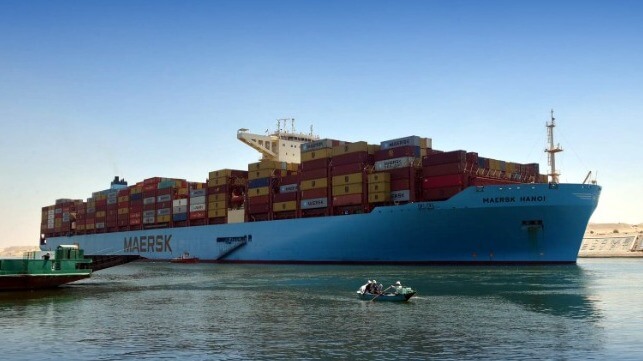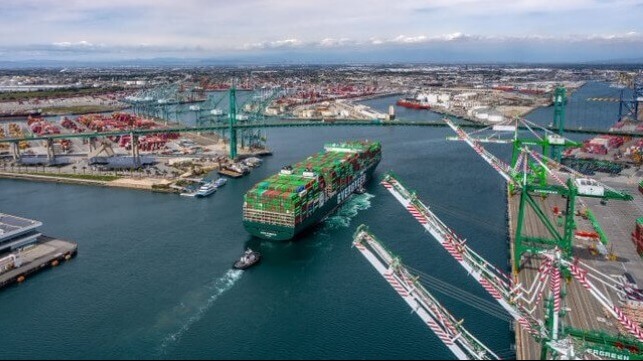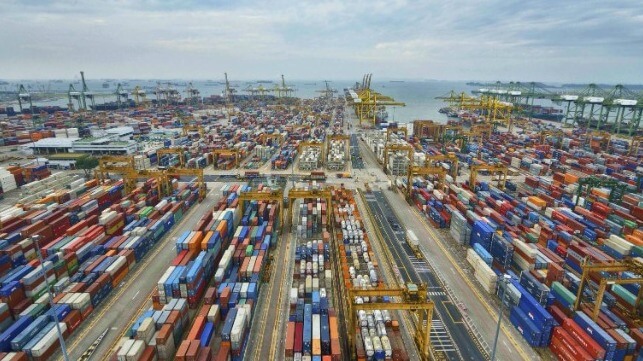Suez Canal Authority Extends Discounts as Traffic and Revenues Plummet

It is now over six months since the Red Sea crisis began and as expected, Egypt’s Suez Canal has taken a hit with the economic impact now becoming clear. Data released this week for last month shows that revenues of the Suez Canal dropped by 64.3 percent to approximately $337.8 million, compared to $648 million recorded in May 2023, according to Egypt’s business newspaper Al-Mal news.
The number of vessels transiting the canal in May also dropped to 1,111, which is lower than 2,396 ships that crossed during a similar period last year. As a result of reduced ship traffic, the cargo volume passing through the Suez Canal dropped by 68.5 percent last month to about 44.9 million tons. In May 2023, the total cargo tonnage was 142.9 million tons.
As the Houthi onslaught on merchant shipping in the Red Sea escalates, major ocean carriers have been forced to avoid the Suez Canal, instead preferring the longer route around Africa.
In February, Egypt’s Finance Minister Mohamed Maait projected that the Suez Canal revenue loss could be absorbed by last year’s stellar performance. The returns during the fiscal year 2022/2023 hit a record-breaking $9.4 billion, representing almost two percent of Egypt’s GDP. However, Maait has cautioned that prolonged tension in the Red Sea could see further revenue loss. This will burden the state treasury, specifically due to rising fluctuations in the exchange rate against the dollar.
Meanwhile, in an attempt to bolster the competiveness of the canal, the Suez Canal Authority (SCA) last week extended fee discounts for a range of vessels on selected long-distance trades. Initially, SCA had introduced the fee reductions back in January, with some discounts as high as 75 percent for product tankers and crude carriers on voyages between Americas and Asia.
The new extension of discount rates will be valid until end of the year, covering 12 categories of ships including bulk carriers, containerships and LNG carriers.
In addition, yachts will also be entitled to a special discount initiative as SCA moves to boost marine tourism in the Red Sea region. This will see introduction of a 50 percent reduction on transit fees for yachts under 300 tons. The promotional measure will effect from July to October and will coincide with the sixth edition of the Egypt International Yacht Show.
Cargo Volumes Dip at Southern California Ports Despite Strong Outlook

Container volumes moving at the Southern California ports dipped in May despite an overall positive trend and positive outlook. While many U.S. ports reported strong growth in volumes both Los Angeles and Long Beach reported monthly declines after a string of monthly year-over-year gains and bucking the trend which saw the overall U.S. trade gap widening in May.
Announcing a decline of over eight percent for total container volumes in May, the Port of Long Beach said “shifting trade routes and canceled voyages led to a decline in cargo.” Imports slid 4.5 percent to 345,271 TEUs while exports decreased 21.1 percent to 100,885 TEUs, for a total of 695,937 TEU in May. The port has been under 700,000 TEU for four of the first five months of 2024 but it came after a strong 750,424 TEU in April.
“I am confident we will see additional cargo as we work with industry partners to rebuild our market share in this increasingly competitive environment,” said Port of Long Beach CEO Mario Cordero.
The neighboring Port of Long Beach similarly reported an approximately three percent decline in total volumes versus May 2023 to just under 753,000 TEU. Imports were off five percent in May 2023 while the port’s executive director Gene Seroka said the results were “in line with projections,” and emphasized the consistent performance of the past few months.
The one strong spot was in exports at the Port of Los Angeles which reached a new milestone of 12 consecutive months of year-over-year gains. Exports were up 24 percent in May to nearly 126,000 loaded TEU with Seroka emphasizing they were working with the agricultural community and others to continue the growth.
While forecasts including the National Retail Federation are calling for continued cargo volume growth, the Port of Los Angeles projected June would be consistent with volume “in the mid to upper 700s TEUs.” While they see it as consistent, they expect unlike 2023 when volumes peaked in June 2023, the outlook is for continued growth.
“As we gear up for the second half of the year, our forecast indicates more robust activity on our docks throughout the summer,” said Seroka.
The Port of Long Beach’s CEO Cordero said “I anticipate a moderate increase in cargo as we move into summer.”
For the first five months of 2024, the Port of Los Angeles’ volume is up 18 percent to 3.9 million TEU. It is below the peak levels when the port surpassed 10 million TEU. Similarly, the Port of Long Beach is up 10 percent so far in 2024 having moved more than 3.4 million TEU.
The West Coast ports continue to work to recover volume as the markets softened after the pandemic and experienced labor uncertainties. A year after settling its longshore contracts the Socal ports highlight that they are well positioned. After volumes shifted to the U.S. East Coast and Gulf Coast during the labor uncertainty, the ports may see a reversal after the International Longshoremen’s Association suspended talks on a U.S. East Coast labor contract. They have threatened a strike if there is no agreement by the expiration of the contract on September 30. 2024.
Port of Seattle Requires All Homeported Cruise Ships to Use Shore Power

The Port of Seattle has become the first port in the United States to require that every homeported cruise ship must use shore power. It follows after a similar rule imposed by the state of California, but is the first time that a port has imposed such a requirement independently.
The port's commission passed the new rule on Tuesday, and it will take effect in the 2027 season. This is three years earlier than anticipated by the port's climate plan.
“In passing this order, the commission turns the port’s 2030 goal of universal shore power use into a 2027 requirement, which is only possible due to the significant investments made by the cruise industry and the port," said Port Commissioner Fred Felleman. "Marketing such investments should also appeal to the environmental interests of travelers who have chosen to cruise to Alaska."
When cruise ships use shore power, they cut their emissions at berth by about 80 percent, according to the port. This saved emissions equaling about 2,700 tonnes of carbon dioxide in the 2023 season, the port said.
To make this possible, the port is extending shore power service to Pier 66, and it should be available to cruise ships there as of this summer. With the completion of this project, all of the port's cruise berths will be shore power-capable, six years ahead of schedule.
The shore power initiative is one aspect of Seattle's "Green Corridor" project with its partner seaports in British Columbia and Alaska. All Seattle-based cruise ships depart for the Inside Passage and Southeast Alaska, calling in either Vancouver or Victoria, and the recurrent port calls make the route amenable for installing and using sustainable fuel infrastructure.
"We appreciate the leadership shown by the Port of Seattle to move ocean going ships off of fossil fuels by committing to transition 100% of homeported cruise vessels to shore power. And, we call on other ports to follow the leadership of the Port of Seattle to move ports and shipping to a zero-emissions future," said Fern Uennatornwaranggoon, Climate Campaign Director for Ports at Pacific Environment.
Red Sea Diversions Are Causing Port Congestion in Singapore

As shipping lines divert traffic away from the Red Sea to avoid the persistent menace of Houthi rebel attacks, new routes are reshaping the patterns of marine traffic and port calls around the world. Vessels normally assigned to other trades have been diverted to the core Asia-Europe service lane, which is now thousands of miles longer than before because of the need to circumnavigate Africa.
One unexpected outcome has been extra demand for bunkering and transshipment at the already-busy port of Singapore, as ships fuel up for a longer haul and offload the cargo that they would previously have delivered to the Mideast on the way to Suez.
As demand for transshipment rose, Singapore's container volume in the first five months of the year climbed nearly eight percent over the same period in 2023. According to Drewry, Singapore's container terminal utilization rate nearly hit 90 percent in May, a level where productivity often begins to decline because of excess crowding. Drewry director Jayendu Krishna told Bloomberg that boxships are "bunching up" in Singapore and other hubs beause of route and schedule changes, leading to congestion.
According to tracking service Portcast, delays at Singapore have extended up to seven days, and up to 450,000 TEU worth of containerized vessel capacity was waiting to berth at the port as of the end of May. Terminal operator PSA Singapore is reactivating some of the facilities at its older Keppel Terminal in response to the extra demand, and some container carriers are skipping the port altogether in order to keep their schedules on time.
"This year, congestion at Singapore Port is primarily caused by ships returning to Asia off-schedule after longer voyages around the African Cape due to the Red Sea crisis and missed weekly sailings," explained Portcast. "The diversions have caused ships to arrive in Asia unpredictably, exacerbating congestion at Singapore’s port."
The disruption in Asian hub ports is helping to support higher container rates, according to Maersk Group. The number-two ocean carrier recently raised its profit outlook for the year, largely because of the effects of congestion and diversion on the supply of container ships.
The Cape of Good Hope diversions have affected about 90 percent of the container ship traffic that once passed through the Red Sea and the Suez Canal. Each diversion adds about $1 million in fuel costs and 1-2 weeks of voyage time, but saves the shipowner up to one percent of the vessel's value in war risk insurance costs. In a new report released Thursday, the U.S. Defense Intelligence Agency said that the Houthi campaign of anti-ship missile strikes has affected the interests of at least 65 nations, according to DIA, and at least 29 major energy and maritime companies have diverted away from the Red Sea because of the risks. The list of affected countries includes Houthi allies and sympathizers, like Iran, Russia and China.
No comments:
Post a Comment